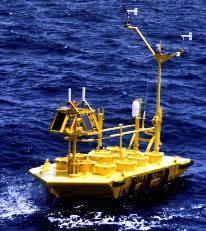Existing weather observation platforms in Prince William Sound include the weather buoys and coastal weather stations of the National Data Buoy Center.
There are two weather buoys already in the Sound — one at Hinchinbrook Entrance and one in Orca Bay — as well as one in the Gulf of Alaska at Cape Suckling.
Two new buoys have been deployed in the northwest Sound at Port Wells, located at the southern end of Montague Island near Cape Cleare.
The NDBC also maintains three automated weather stations at Bligh Reef, Potato Point, and Middle Rock along the vessel traffic lane leading to the Port of Valdez oil terminal.
See the locations of the NDBC buoys in the Sound
About the Buoys
The weather buoys in the Sound are typically three meters in diameter, although larger six-meter buoys are used for stability in rougher or more open waters such as Hinchinbrook Entrance. The buoys carry an array of instruments that measure:
- Wind speed and direction
- Air pressure
- Air temperature
- Sea surface temperature
Cooperative Efforts
NDBC buoys provide a platform for placement of additional instruments by other organizations. For example, AOOS has upgraded each of the three buoys in the Sound with instruments that measure ocean temperature, salinity, and current velocity.
Measuring Ocean Currents
We measure current velocity with an Acoustic Doppler Current Profiler (ADCP). ADCPs measure Doppler shifts to calculate the speed of moving water. We experience Doppler shifts in everyday life; think, for example, of the change in sound of passing cars when walking on the side of the road.
ADCPs emit a sound at a given frequency and listen to the echo of this sound after it has bounced on small particles naturally present in seawater. We can estimate the distance between the instrument and the reflecting particles, using the delay between the emission of the sound and the arrival of the echo.
If the echo from a given distance arrives with a higher frequency than the emitted sound, then the volume of water at this distance is moving toward the instrument. If the echo arrives with a lower frequency, then this volume of water is moving away. Larger shifts in frequency indicate larger current speeds.


